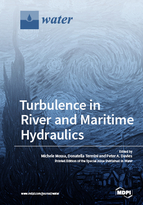Turbulence in River and Maritime Hydraulics
A special issue of Water (ISSN 2073-4441). This special issue belongs to the section "Hydraulics and Hydrodynamics".
Deadline for manuscript submissions: closed (28 February 2018) | Viewed by 74368
Special Issue Editors
Interests: hydraulics; fluid mechanics; environmental hydraulics; maritime hydraulics; rivers and stream; contaminant transport; physical models in hydraulics; tidal mixing; wastewater disposal; stratification
Interests: present research efforts include the investigation in fluvial hydraulics and eco-hydraulics (flow resistance, effect of vegetation, sediment transport, effects of bed roughness), prediction of river morphological evolution (meandering and braiding) both through experimental investigations and by the development of numerical simulation codes
Special Issues, Collections and Topics in MDPI journals
Special Issue Information
Dear Colleagues,
You are kindly invited to submit a manuscript on any aspect of theoretical analysis and/or experimental results on river and maritime hydraulics, highlighting the most recent breakthrough(s) in the processes of contaminant and particle transport and mixing processes.
The papers will be published in a Special Issue of Water, with the main aim being to present the state-of-the-art knowledge of complex environmental flows to researchers and practitioners.
The content of the paper is at your discretion, but an overview of a particular topic of research in your area of expertise and an exposure of the current and future challenges associated with this topic would be particularly valuable.
Prof. Dr. Michele Mossa
Prof. Dr. Donatella Termini
Prof. Dr. Peter A. Davies
Guest Editors
Manuscript Submission Information
Manuscripts should be submitted online at www.mdpi.com by registering and logging in to this website. Once you are registered, click here to go to the submission form. Manuscripts can be submitted until the deadline. All submissions that pass pre-check are peer-reviewed. Accepted papers will be published continuously in the journal (as soon as accepted) and will be listed together on the special issue website. Research articles, review articles as well as short communications are invited. For planned papers, a title and short abstract (about 100 words) can be sent to the Editorial Office for announcement on this website.
Submitted manuscripts should not have been published previously, nor be under consideration for publication elsewhere (except conference proceedings papers). All manuscripts are thoroughly refereed through a single-blind peer-review process. A guide for authors and other relevant information for submission of manuscripts is available on the Instructions for Authors page. Water is an international peer-reviewed open access semimonthly journal published by MDPI.
Please visit the Instructions for Authors page before submitting a manuscript. The Article Processing Charge (APC) for publication in this open access journal is 2600 CHF (Swiss Francs). Submitted papers should be well formatted and use good English. Authors may use MDPI's English editing service prior to publication or during author revisions.
Keywords
-
environmental hydraulics
-
contaminant transport, particle transport and mixing process
-
stratified flows
-
turbulence








